Analysis of Leadership in Health and Social Care: Theories and Roles
VerifiedAdded on 2023/01/18
|17
|5311
|24
Report
AI Summary
This report examines leadership within the health and social care sector, focusing on the case of Emmie, a recent graduate in health management. It addresses key leadership roles and theories, including transformational and contingency theories, crucial for effective management. The report analyzes the importance of leadership in guiding and motivating teams, fostering a positive working environment, ensuring coordination, and inducing necessary changes within the organization. Furthermore, it explores how these theoretical models contribute to successful team building, discussing the stages of team development and strategies to motivate team members toward achieving organizational objectives. The report also provides recommendations for open communication between leaders and team members to support engagement and facilitate team development within the health and social care environment.
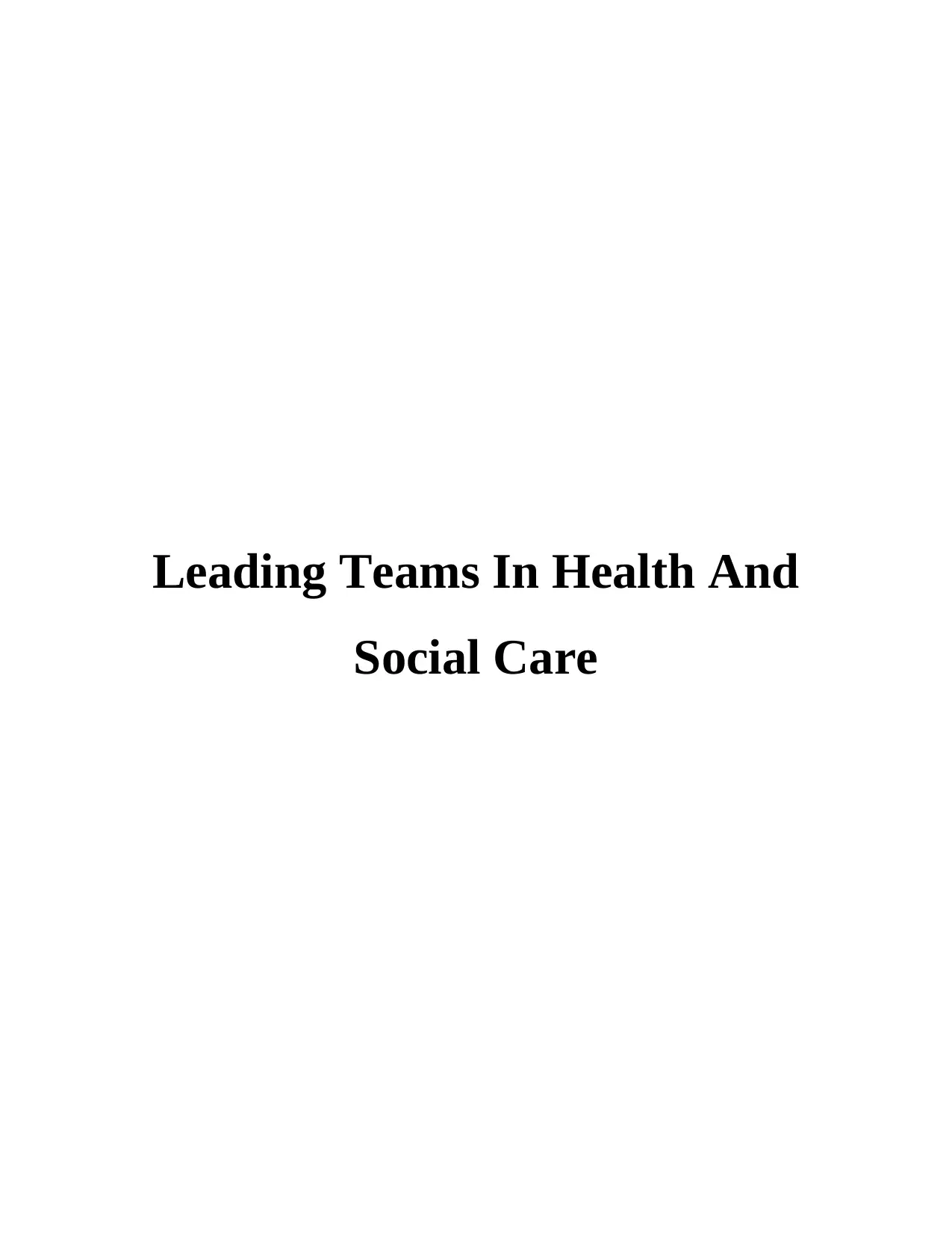
Leading Teams In Health And
Social Care
Social Care
Paraphrase This Document
Need a fresh take? Get an instant paraphrase of this document with our AI Paraphraser
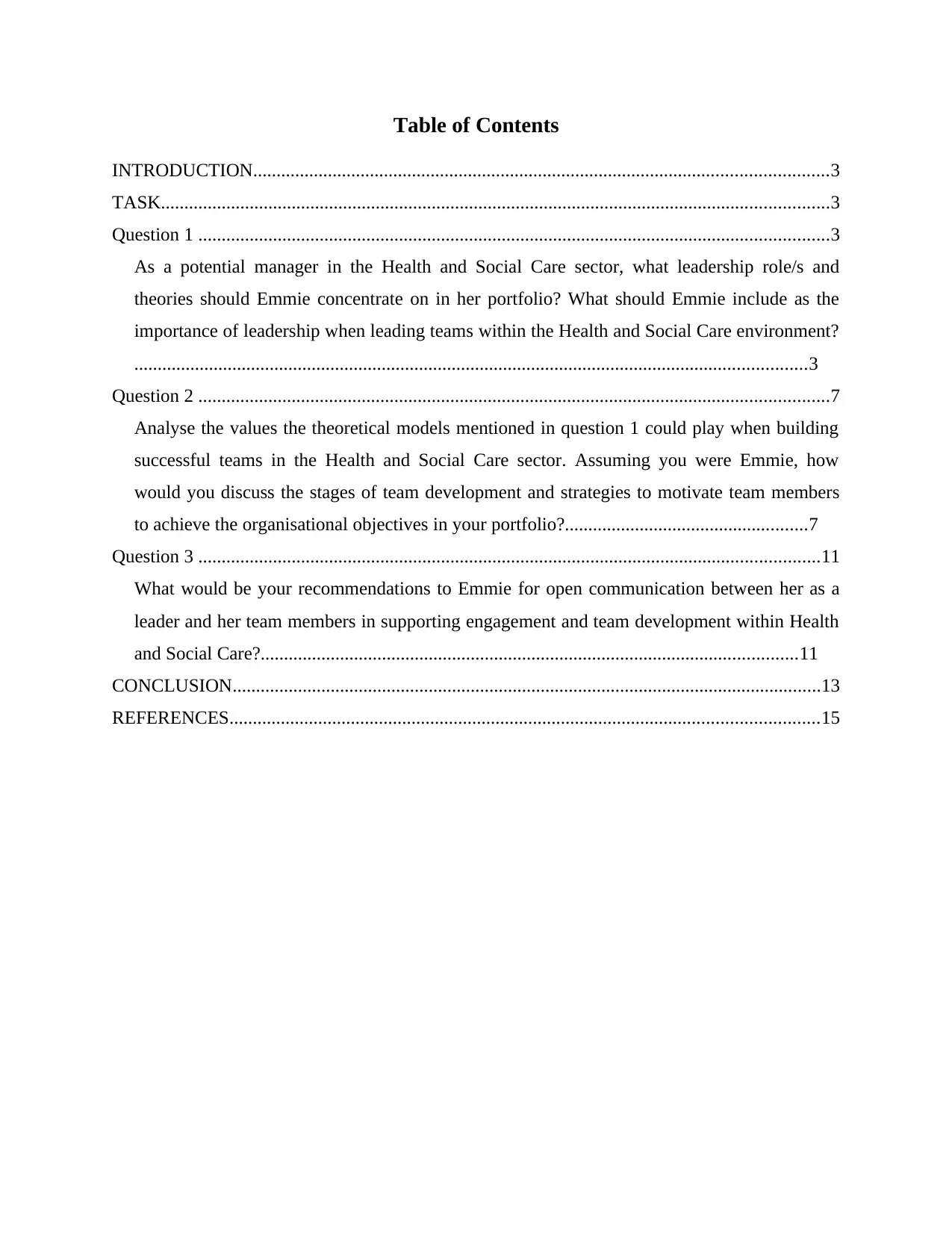
Table of Contents
INTRODUCTION...........................................................................................................................3
TASK...............................................................................................................................................3
Question 1 .......................................................................................................................................3
As a potential manager in the Health and Social Care sector, what leadership role/s and
theories should Emmie concentrate on in her portfolio? What should Emmie include as the
importance of leadership when leading teams within the Health and Social Care environment?
................................................................................................................................................3
Question 2 .......................................................................................................................................7
Analyse the values the theoretical models mentioned in question 1 could play when building
successful teams in the Health and Social Care sector. Assuming you were Emmie, how
would you discuss the stages of team development and strategies to motivate team members
to achieve the organisational objectives in your portfolio?....................................................7
Question 3 .....................................................................................................................................11
What would be your recommendations to Emmie for open communication between her as a
leader and her team members in supporting engagement and team development within Health
and Social Care?...................................................................................................................11
CONCLUSION..............................................................................................................................13
REFERENCES..............................................................................................................................15
INTRODUCTION...........................................................................................................................3
TASK...............................................................................................................................................3
Question 1 .......................................................................................................................................3
As a potential manager in the Health and Social Care sector, what leadership role/s and
theories should Emmie concentrate on in her portfolio? What should Emmie include as the
importance of leadership when leading teams within the Health and Social Care environment?
................................................................................................................................................3
Question 2 .......................................................................................................................................7
Analyse the values the theoretical models mentioned in question 1 could play when building
successful teams in the Health and Social Care sector. Assuming you were Emmie, how
would you discuss the stages of team development and strategies to motivate team members
to achieve the organisational objectives in your portfolio?....................................................7
Question 3 .....................................................................................................................................11
What would be your recommendations to Emmie for open communication between her as a
leader and her team members in supporting engagement and team development within Health
and Social Care?...................................................................................................................11
CONCLUSION..............................................................................................................................13
REFERENCES..............................................................................................................................15

⊘ This is a preview!⊘
Do you want full access?
Subscribe today to unlock all pages.

Trusted by 1+ million students worldwide
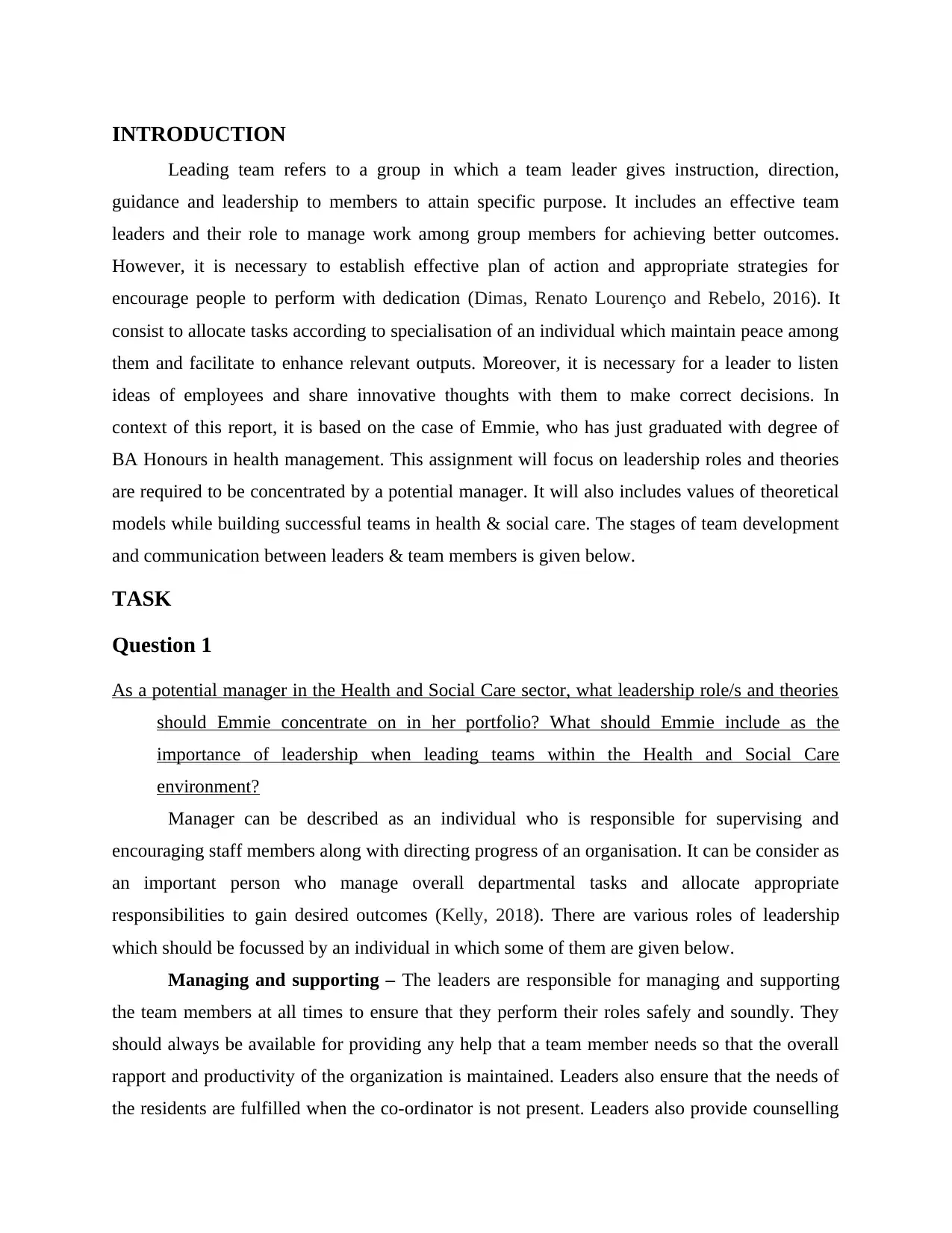
INTRODUCTION
Leading team refers to a group in which a team leader gives instruction, direction,
guidance and leadership to members to attain specific purpose. It includes an effective team
leaders and their role to manage work among group members for achieving better outcomes.
However, it is necessary to establish effective plan of action and appropriate strategies for
encourage people to perform with dedication (Dimas, Renato Lourenço and Rebelo, 2016). It
consist to allocate tasks according to specialisation of an individual which maintain peace among
them and facilitate to enhance relevant outputs. Moreover, it is necessary for a leader to listen
ideas of employees and share innovative thoughts with them to make correct decisions. In
context of this report, it is based on the case of Emmie, who has just graduated with degree of
BA Honours in health management. This assignment will focus on leadership roles and theories
are required to be concentrated by a potential manager. It will also includes values of theoretical
models while building successful teams in health & social care. The stages of team development
and communication between leaders & team members is given below.
TASK
Question 1
As a potential manager in the Health and Social Care sector, what leadership role/s and theories
should Emmie concentrate on in her portfolio? What should Emmie include as the
importance of leadership when leading teams within the Health and Social Care
environment?
Manager can be described as an individual who is responsible for supervising and
encouraging staff members along with directing progress of an organisation. It can be consider as
an important person who manage overall departmental tasks and allocate appropriate
responsibilities to gain desired outcomes (Kelly, 2018). There are various roles of leadership
which should be focussed by an individual in which some of them are given below.
Managing and supporting – The leaders are responsible for managing and supporting
the team members at all times to ensure that they perform their roles safely and soundly. They
should always be available for providing any help that a team member needs so that the overall
rapport and productivity of the organization is maintained. Leaders also ensure that the needs of
the residents are fulfilled when the co-ordinator is not present. Leaders also provide counselling
Leading team refers to a group in which a team leader gives instruction, direction,
guidance and leadership to members to attain specific purpose. It includes an effective team
leaders and their role to manage work among group members for achieving better outcomes.
However, it is necessary to establish effective plan of action and appropriate strategies for
encourage people to perform with dedication (Dimas, Renato Lourenço and Rebelo, 2016). It
consist to allocate tasks according to specialisation of an individual which maintain peace among
them and facilitate to enhance relevant outputs. Moreover, it is necessary for a leader to listen
ideas of employees and share innovative thoughts with them to make correct decisions. In
context of this report, it is based on the case of Emmie, who has just graduated with degree of
BA Honours in health management. This assignment will focus on leadership roles and theories
are required to be concentrated by a potential manager. It will also includes values of theoretical
models while building successful teams in health & social care. The stages of team development
and communication between leaders & team members is given below.
TASK
Question 1
As a potential manager in the Health and Social Care sector, what leadership role/s and theories
should Emmie concentrate on in her portfolio? What should Emmie include as the
importance of leadership when leading teams within the Health and Social Care
environment?
Manager can be described as an individual who is responsible for supervising and
encouraging staff members along with directing progress of an organisation. It can be consider as
an important person who manage overall departmental tasks and allocate appropriate
responsibilities to gain desired outcomes (Kelly, 2018). There are various roles of leadership
which should be focussed by an individual in which some of them are given below.
Managing and supporting – The leaders are responsible for managing and supporting
the team members at all times to ensure that they perform their roles safely and soundly. They
should always be available for providing any help that a team member needs so that the overall
rapport and productivity of the organization is maintained. Leaders also ensure that the needs of
the residents are fulfilled when the co-ordinator is not present. Leaders also provide counselling
Paraphrase This Document
Need a fresh take? Get an instant paraphrase of this document with our AI Paraphraser
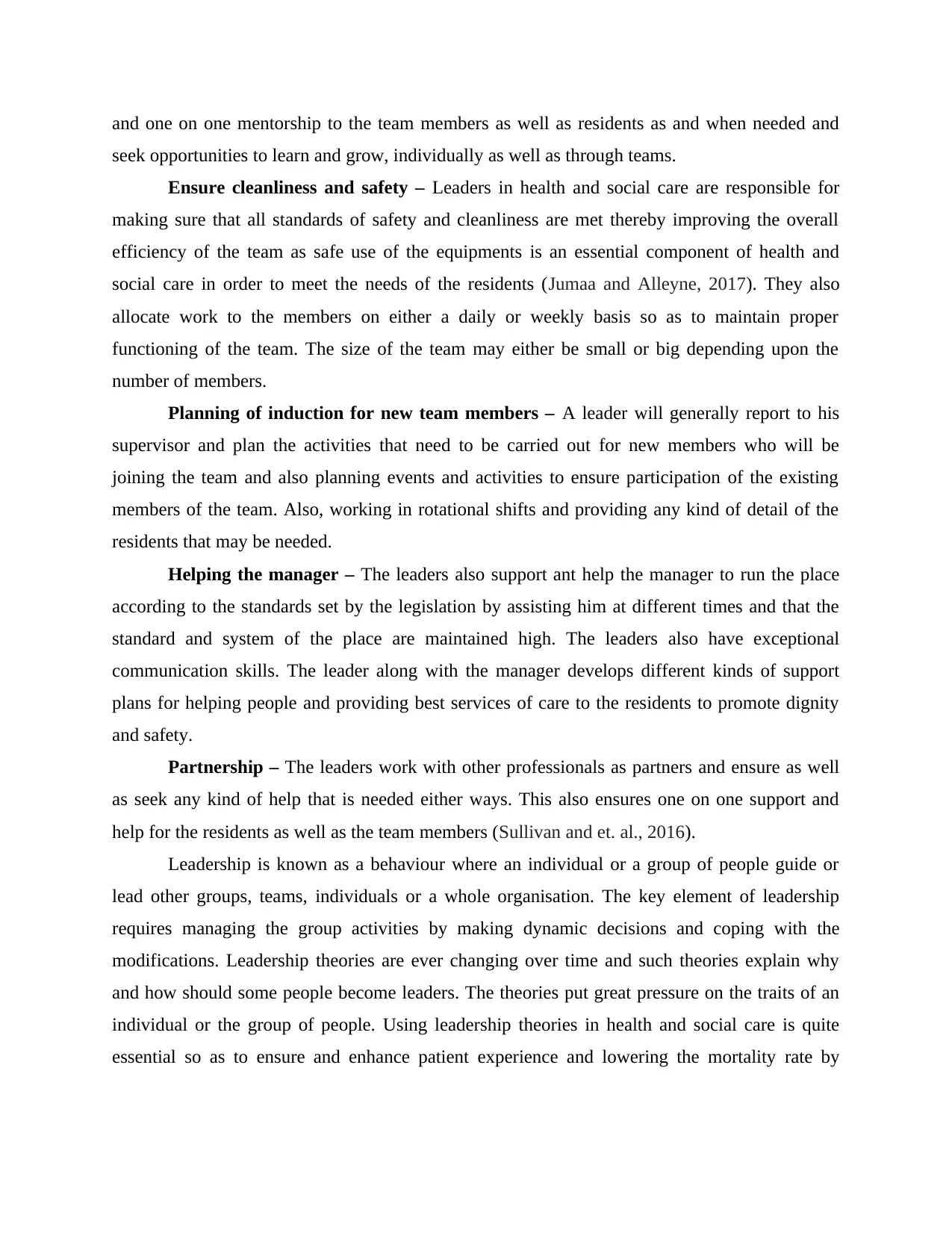
and one on one mentorship to the team members as well as residents as and when needed and
seek opportunities to learn and grow, individually as well as through teams.
Ensure cleanliness and safety – Leaders in health and social care are responsible for
making sure that all standards of safety and cleanliness are met thereby improving the overall
efficiency of the team as safe use of the equipments is an essential component of health and
social care in order to meet the needs of the residents (Jumaa and Alleyne, 2017). They also
allocate work to the members on either a daily or weekly basis so as to maintain proper
functioning of the team. The size of the team may either be small or big depending upon the
number of members.
Planning of induction for new team members – A leader will generally report to his
supervisor and plan the activities that need to be carried out for new members who will be
joining the team and also planning events and activities to ensure participation of the existing
members of the team. Also, working in rotational shifts and providing any kind of detail of the
residents that may be needed.
Helping the manager – The leaders also support ant help the manager to run the place
according to the standards set by the legislation by assisting him at different times and that the
standard and system of the place are maintained high. The leaders also have exceptional
communication skills. The leader along with the manager develops different kinds of support
plans for helping people and providing best services of care to the residents to promote dignity
and safety.
Partnership – The leaders work with other professionals as partners and ensure as well
as seek any kind of help that is needed either ways. This also ensures one on one support and
help for the residents as well as the team members (Sullivan and et. al., 2016).
Leadership is known as a behaviour where an individual or a group of people guide or
lead other groups, teams, individuals or a whole organisation. The key element of leadership
requires managing the group activities by making dynamic decisions and coping with the
modifications. Leadership theories are ever changing over time and such theories explain why
and how should some people become leaders. The theories put great pressure on the traits of an
individual or the group of people. Using leadership theories in health and social care is quite
essential so as to ensure and enhance patient experience and lowering the mortality rate by
seek opportunities to learn and grow, individually as well as through teams.
Ensure cleanliness and safety – Leaders in health and social care are responsible for
making sure that all standards of safety and cleanliness are met thereby improving the overall
efficiency of the team as safe use of the equipments is an essential component of health and
social care in order to meet the needs of the residents (Jumaa and Alleyne, 2017). They also
allocate work to the members on either a daily or weekly basis so as to maintain proper
functioning of the team. The size of the team may either be small or big depending upon the
number of members.
Planning of induction for new team members – A leader will generally report to his
supervisor and plan the activities that need to be carried out for new members who will be
joining the team and also planning events and activities to ensure participation of the existing
members of the team. Also, working in rotational shifts and providing any kind of detail of the
residents that may be needed.
Helping the manager – The leaders also support ant help the manager to run the place
according to the standards set by the legislation by assisting him at different times and that the
standard and system of the place are maintained high. The leaders also have exceptional
communication skills. The leader along with the manager develops different kinds of support
plans for helping people and providing best services of care to the residents to promote dignity
and safety.
Partnership – The leaders work with other professionals as partners and ensure as well
as seek any kind of help that is needed either ways. This also ensures one on one support and
help for the residents as well as the team members (Sullivan and et. al., 2016).
Leadership is known as a behaviour where an individual or a group of people guide or
lead other groups, teams, individuals or a whole organisation. The key element of leadership
requires managing the group activities by making dynamic decisions and coping with the
modifications. Leadership theories are ever changing over time and such theories explain why
and how should some people become leaders. The theories put great pressure on the traits of an
individual or the group of people. Using leadership theories in health and social care is quite
essential so as to ensure and enhance patient experience and lowering the mortality rate by
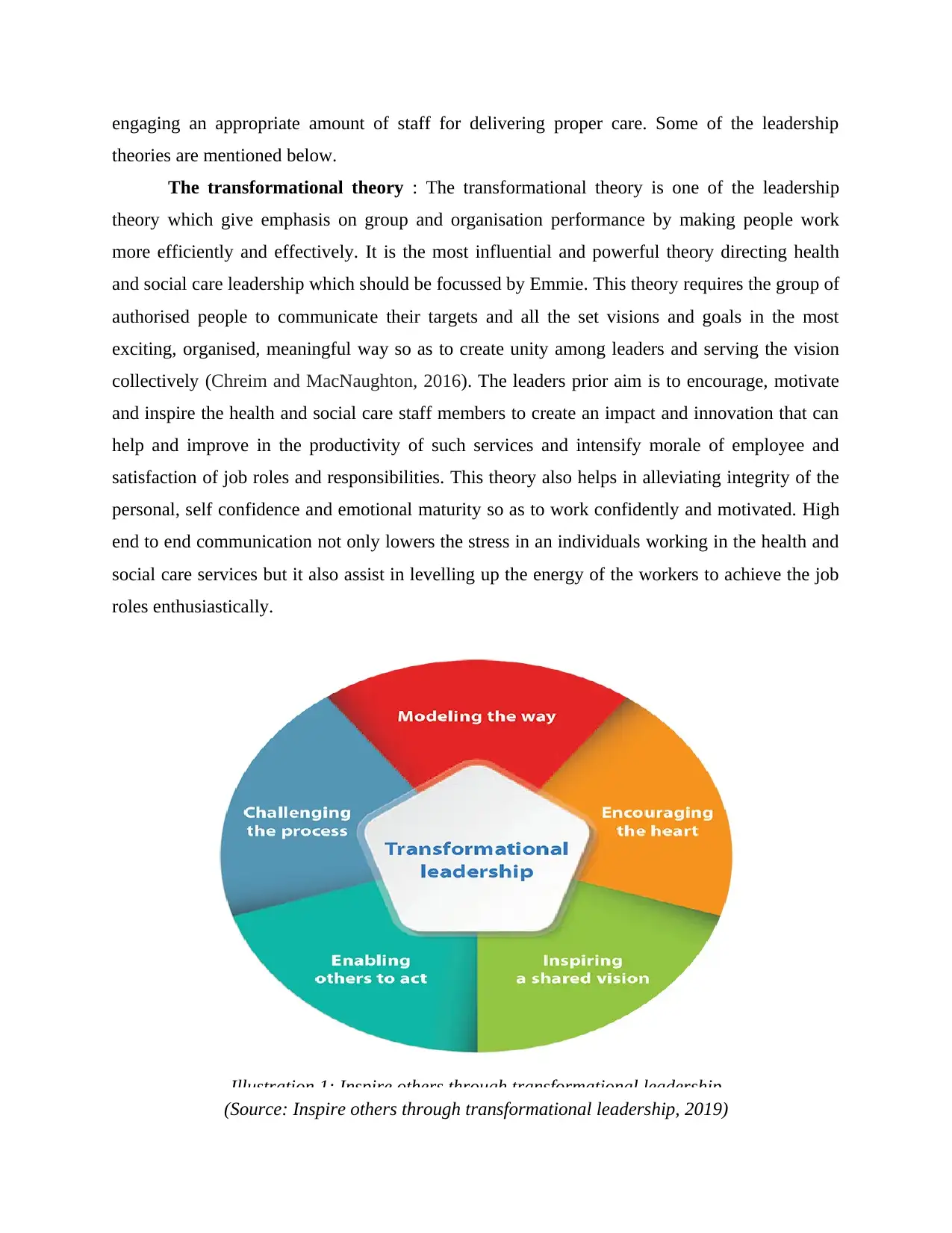
engaging an appropriate amount of staff for delivering proper care. Some of the leadership
theories are mentioned below.
The transformational theory : The transformational theory is one of the leadership
theory which give emphasis on group and organisation performance by making people work
more efficiently and effectively. It is the most influential and powerful theory directing health
and social care leadership which should be focussed by Emmie. This theory requires the group of
authorised people to communicate their targets and all the set visions and goals in the most
exciting, organised, meaningful way so as to create unity among leaders and serving the vision
collectively (Chreim and MacNaughton, 2016). The leaders prior aim is to encourage, motivate
and inspire the health and social care staff members to create an impact and innovation that can
help and improve in the productivity of such services and intensify morale of employee and
satisfaction of job roles and responsibilities. This theory also helps in alleviating integrity of the
personal, self confidence and emotional maturity so as to work confidently and motivated. High
end to end communication not only lowers the stress in an individuals working in the health and
social care services but it also assist in levelling up the energy of the workers to achieve the job
roles enthusiastically.
(Source: Inspire others through transformational leadership, 2019)
Illustration 1: Inspire others through transformational leadership
theories are mentioned below.
The transformational theory : The transformational theory is one of the leadership
theory which give emphasis on group and organisation performance by making people work
more efficiently and effectively. It is the most influential and powerful theory directing health
and social care leadership which should be focussed by Emmie. This theory requires the group of
authorised people to communicate their targets and all the set visions and goals in the most
exciting, organised, meaningful way so as to create unity among leaders and serving the vision
collectively (Chreim and MacNaughton, 2016). The leaders prior aim is to encourage, motivate
and inspire the health and social care staff members to create an impact and innovation that can
help and improve in the productivity of such services and intensify morale of employee and
satisfaction of job roles and responsibilities. This theory also helps in alleviating integrity of the
personal, self confidence and emotional maturity so as to work confidently and motivated. High
end to end communication not only lowers the stress in an individuals working in the health and
social care services but it also assist in levelling up the energy of the workers to achieve the job
roles enthusiastically.
(Source: Inspire others through transformational leadership, 2019)
Illustration 1: Inspire others through transformational leadership
⊘ This is a preview!⊘
Do you want full access?
Subscribe today to unlock all pages.

Trusted by 1+ million students worldwide
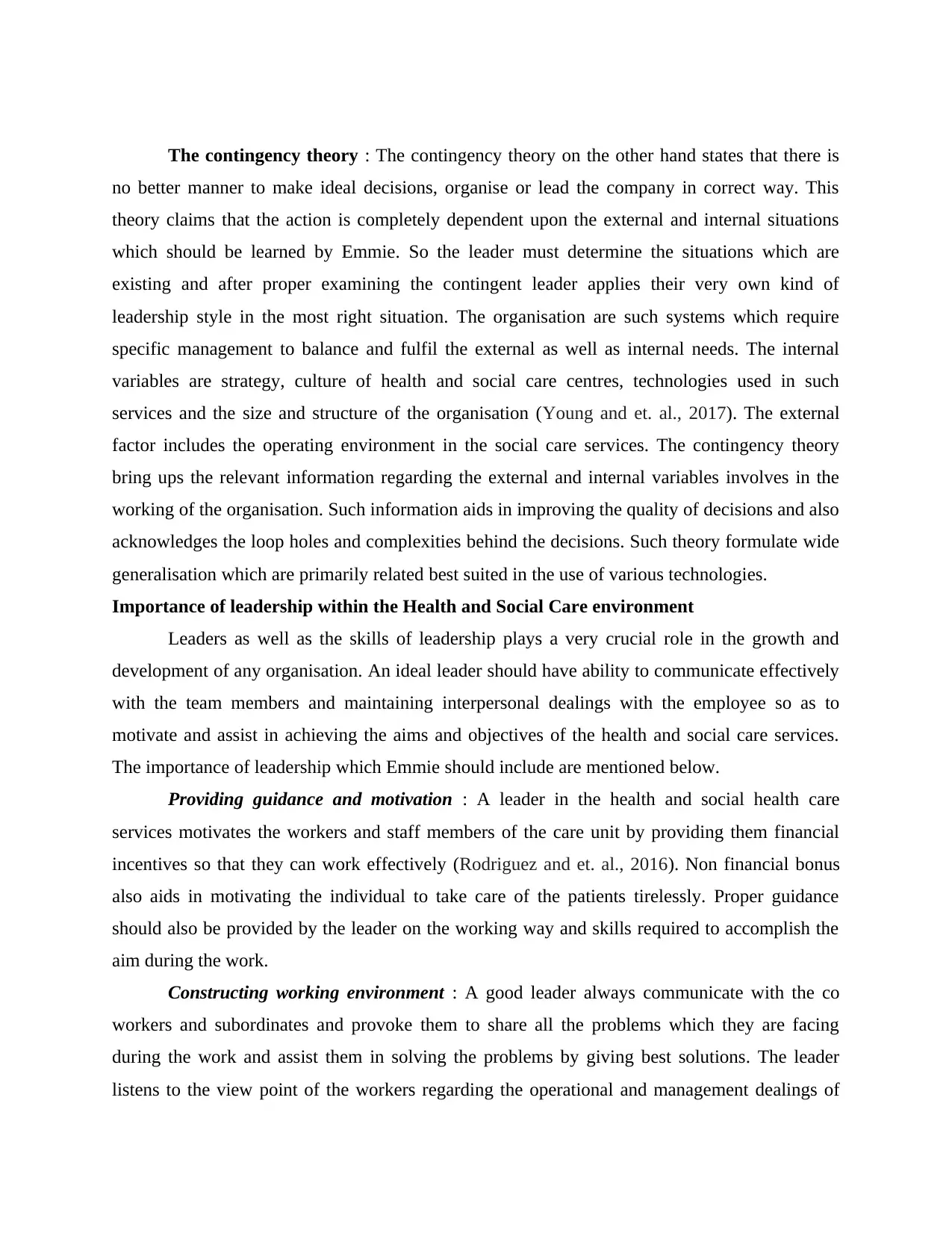
The contingency theory : The contingency theory on the other hand states that there is
no better manner to make ideal decisions, organise or lead the company in correct way. This
theory claims that the action is completely dependent upon the external and internal situations
which should be learned by Emmie. So the leader must determine the situations which are
existing and after proper examining the contingent leader applies their very own kind of
leadership style in the most right situation. The organisation are such systems which require
specific management to balance and fulfil the external as well as internal needs. The internal
variables are strategy, culture of health and social care centres, technologies used in such
services and the size and structure of the organisation (Young and et. al., 2017). The external
factor includes the operating environment in the social care services. The contingency theory
bring ups the relevant information regarding the external and internal variables involves in the
working of the organisation. Such information aids in improving the quality of decisions and also
acknowledges the loop holes and complexities behind the decisions. Such theory formulate wide
generalisation which are primarily related best suited in the use of various technologies.
Importance of leadership within the Health and Social Care environment
Leaders as well as the skills of leadership plays a very crucial role in the growth and
development of any organisation. An ideal leader should have ability to communicate effectively
with the team members and maintaining interpersonal dealings with the employee so as to
motivate and assist in achieving the aims and objectives of the health and social care services.
The importance of leadership which Emmie should include are mentioned below.
Providing guidance and motivation : A leader in the health and social health care
services motivates the workers and staff members of the care unit by providing them financial
incentives so that they can work effectively (Rodriguez and et. al., 2016). Non financial bonus
also aids in motivating the individual to take care of the patients tirelessly. Proper guidance
should also be provided by the leader on the working way and skills required to accomplish the
aim during the work.
Constructing working environment : A good leader always communicate with the co
workers and subordinates and provoke them to share all the problems which they are facing
during the work and assist them in solving the problems by giving best solutions. The leader
listens to the view point of the workers regarding the operational and management dealings of
no better manner to make ideal decisions, organise or lead the company in correct way. This
theory claims that the action is completely dependent upon the external and internal situations
which should be learned by Emmie. So the leader must determine the situations which are
existing and after proper examining the contingent leader applies their very own kind of
leadership style in the most right situation. The organisation are such systems which require
specific management to balance and fulfil the external as well as internal needs. The internal
variables are strategy, culture of health and social care centres, technologies used in such
services and the size and structure of the organisation (Young and et. al., 2017). The external
factor includes the operating environment in the social care services. The contingency theory
bring ups the relevant information regarding the external and internal variables involves in the
working of the organisation. Such information aids in improving the quality of decisions and also
acknowledges the loop holes and complexities behind the decisions. Such theory formulate wide
generalisation which are primarily related best suited in the use of various technologies.
Importance of leadership within the Health and Social Care environment
Leaders as well as the skills of leadership plays a very crucial role in the growth and
development of any organisation. An ideal leader should have ability to communicate effectively
with the team members and maintaining interpersonal dealings with the employee so as to
motivate and assist in achieving the aims and objectives of the health and social care services.
The importance of leadership which Emmie should include are mentioned below.
Providing guidance and motivation : A leader in the health and social health care
services motivates the workers and staff members of the care unit by providing them financial
incentives so that they can work effectively (Rodriguez and et. al., 2016). Non financial bonus
also aids in motivating the individual to take care of the patients tirelessly. Proper guidance
should also be provided by the leader on the working way and skills required to accomplish the
aim during the work.
Constructing working environment : A good leader always communicate with the co
workers and subordinates and provoke them to share all the problems which they are facing
during the work and assist them in solving the problems by giving best solutions. The leader
listens to the view point of the workers regarding the operational and management dealings of
Paraphrase This Document
Need a fresh take? Get an instant paraphrase of this document with our AI Paraphraser
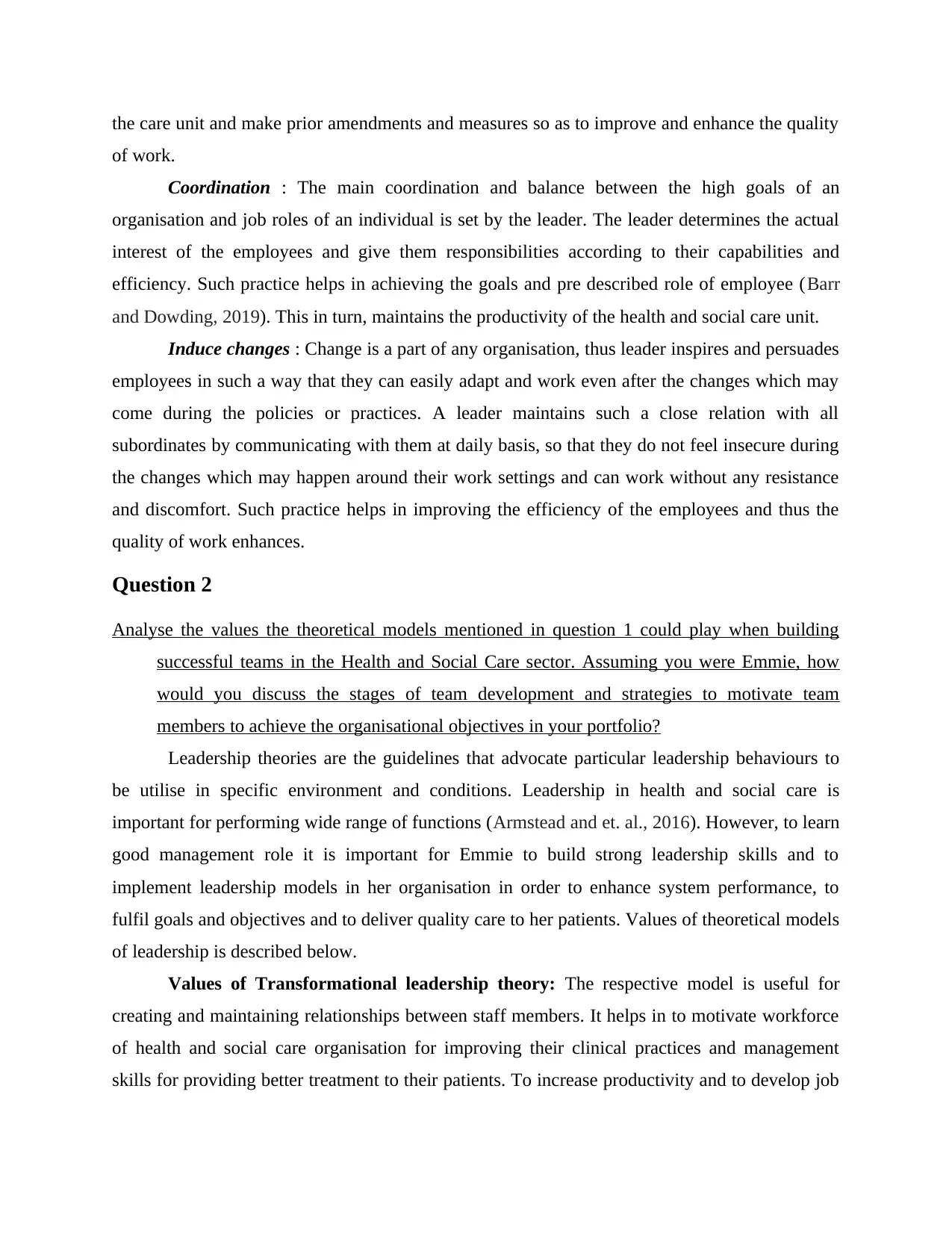
the care unit and make prior amendments and measures so as to improve and enhance the quality
of work.
Coordination : The main coordination and balance between the high goals of an
organisation and job roles of an individual is set by the leader. The leader determines the actual
interest of the employees and give them responsibilities according to their capabilities and
efficiency. Such practice helps in achieving the goals and pre described role of employee (Barr
and Dowding, 2019). This in turn, maintains the productivity of the health and social care unit.
Induce changes : Change is a part of any organisation, thus leader inspires and persuades
employees in such a way that they can easily adapt and work even after the changes which may
come during the policies or practices. A leader maintains such a close relation with all
subordinates by communicating with them at daily basis, so that they do not feel insecure during
the changes which may happen around their work settings and can work without any resistance
and discomfort. Such practice helps in improving the efficiency of the employees and thus the
quality of work enhances.
Question 2
Analyse the values the theoretical models mentioned in question 1 could play when building
successful teams in the Health and Social Care sector. Assuming you were Emmie, how
would you discuss the stages of team development and strategies to motivate team
members to achieve the organisational objectives in your portfolio?
Leadership theories are the guidelines that advocate particular leadership behaviours to
be utilise in specific environment and conditions. Leadership in health and social care is
important for performing wide range of functions (Armstead and et. al., 2016). However, to learn
good management role it is important for Emmie to build strong leadership skills and to
implement leadership models in her organisation in order to enhance system performance, to
fulfil goals and objectives and to deliver quality care to her patients. Values of theoretical models
of leadership is described below.
Values of Transformational leadership theory: The respective model is useful for
creating and maintaining relationships between staff members. It helps in to motivate workforce
of health and social care organisation for improving their clinical practices and management
skills for providing better treatment to their patients. To increase productivity and to develop job
of work.
Coordination : The main coordination and balance between the high goals of an
organisation and job roles of an individual is set by the leader. The leader determines the actual
interest of the employees and give them responsibilities according to their capabilities and
efficiency. Such practice helps in achieving the goals and pre described role of employee (Barr
and Dowding, 2019). This in turn, maintains the productivity of the health and social care unit.
Induce changes : Change is a part of any organisation, thus leader inspires and persuades
employees in such a way that they can easily adapt and work even after the changes which may
come during the policies or practices. A leader maintains such a close relation with all
subordinates by communicating with them at daily basis, so that they do not feel insecure during
the changes which may happen around their work settings and can work without any resistance
and discomfort. Such practice helps in improving the efficiency of the employees and thus the
quality of work enhances.
Question 2
Analyse the values the theoretical models mentioned in question 1 could play when building
successful teams in the Health and Social Care sector. Assuming you were Emmie, how
would you discuss the stages of team development and strategies to motivate team
members to achieve the organisational objectives in your portfolio?
Leadership theories are the guidelines that advocate particular leadership behaviours to
be utilise in specific environment and conditions. Leadership in health and social care is
important for performing wide range of functions (Armstead and et. al., 2016). However, to learn
good management role it is important for Emmie to build strong leadership skills and to
implement leadership models in her organisation in order to enhance system performance, to
fulfil goals and objectives and to deliver quality care to her patients. Values of theoretical models
of leadership is described below.
Values of Transformational leadership theory: The respective model is useful for
creating and maintaining relationships between staff members. It helps in to motivate workforce
of health and social care organisation for improving their clinical practices and management
skills for providing better treatment to their patients. To increase productivity and to develop job
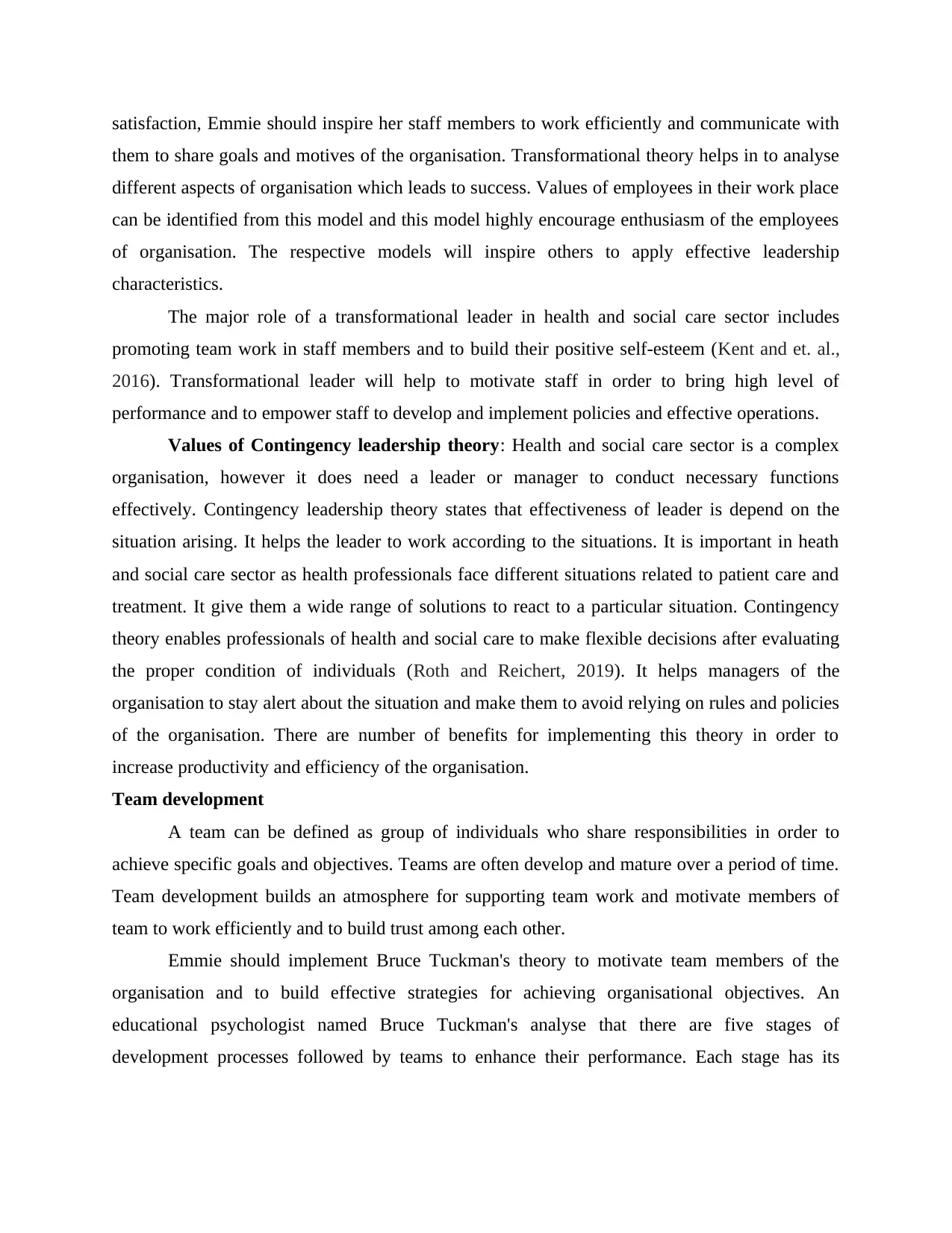
satisfaction, Emmie should inspire her staff members to work efficiently and communicate with
them to share goals and motives of the organisation. Transformational theory helps in to analyse
different aspects of organisation which leads to success. Values of employees in their work place
can be identified from this model and this model highly encourage enthusiasm of the employees
of organisation. The respective models will inspire others to apply effective leadership
characteristics.
The major role of a transformational leader in health and social care sector includes
promoting team work in staff members and to build their positive self-esteem (Kent and et. al.,
2016). Transformational leader will help to motivate staff in order to bring high level of
performance and to empower staff to develop and implement policies and effective operations.
Values of Contingency leadership theory: Health and social care sector is a complex
organisation, however it does need a leader or manager to conduct necessary functions
effectively. Contingency leadership theory states that effectiveness of leader is depend on the
situation arising. It helps the leader to work according to the situations. It is important in heath
and social care sector as health professionals face different situations related to patient care and
treatment. It give them a wide range of solutions to react to a particular situation. Contingency
theory enables professionals of health and social care to make flexible decisions after evaluating
the proper condition of individuals (Roth and Reichert, 2019). It helps managers of the
organisation to stay alert about the situation and make them to avoid relying on rules and policies
of the organisation. There are number of benefits for implementing this theory in order to
increase productivity and efficiency of the organisation.
Team development
A team can be defined as group of individuals who share responsibilities in order to
achieve specific goals and objectives. Teams are often develop and mature over a period of time.
Team development builds an atmosphere for supporting team work and motivate members of
team to work efficiently and to build trust among each other.
Emmie should implement Bruce Tuckman's theory to motivate team members of the
organisation and to build effective strategies for achieving organisational objectives. An
educational psychologist named Bruce Tuckman's analyse that there are five stages of
development processes followed by teams to enhance their performance. Each stage has its
them to share goals and motives of the organisation. Transformational theory helps in to analyse
different aspects of organisation which leads to success. Values of employees in their work place
can be identified from this model and this model highly encourage enthusiasm of the employees
of organisation. The respective models will inspire others to apply effective leadership
characteristics.
The major role of a transformational leader in health and social care sector includes
promoting team work in staff members and to build their positive self-esteem (Kent and et. al.,
2016). Transformational leader will help to motivate staff in order to bring high level of
performance and to empower staff to develop and implement policies and effective operations.
Values of Contingency leadership theory: Health and social care sector is a complex
organisation, however it does need a leader or manager to conduct necessary functions
effectively. Contingency leadership theory states that effectiveness of leader is depend on the
situation arising. It helps the leader to work according to the situations. It is important in heath
and social care sector as health professionals face different situations related to patient care and
treatment. It give them a wide range of solutions to react to a particular situation. Contingency
theory enables professionals of health and social care to make flexible decisions after evaluating
the proper condition of individuals (Roth and Reichert, 2019). It helps managers of the
organisation to stay alert about the situation and make them to avoid relying on rules and policies
of the organisation. There are number of benefits for implementing this theory in order to
increase productivity and efficiency of the organisation.
Team development
A team can be defined as group of individuals who share responsibilities in order to
achieve specific goals and objectives. Teams are often develop and mature over a period of time.
Team development builds an atmosphere for supporting team work and motivate members of
team to work efficiently and to build trust among each other.
Emmie should implement Bruce Tuckman's theory to motivate team members of the
organisation and to build effective strategies for achieving organisational objectives. An
educational psychologist named Bruce Tuckman's analyse that there are five stages of
development processes followed by teams to enhance their performance. Each stage has its
⊘ This is a preview!⊘
Do you want full access?
Subscribe today to unlock all pages.

Trusted by 1+ million students worldwide
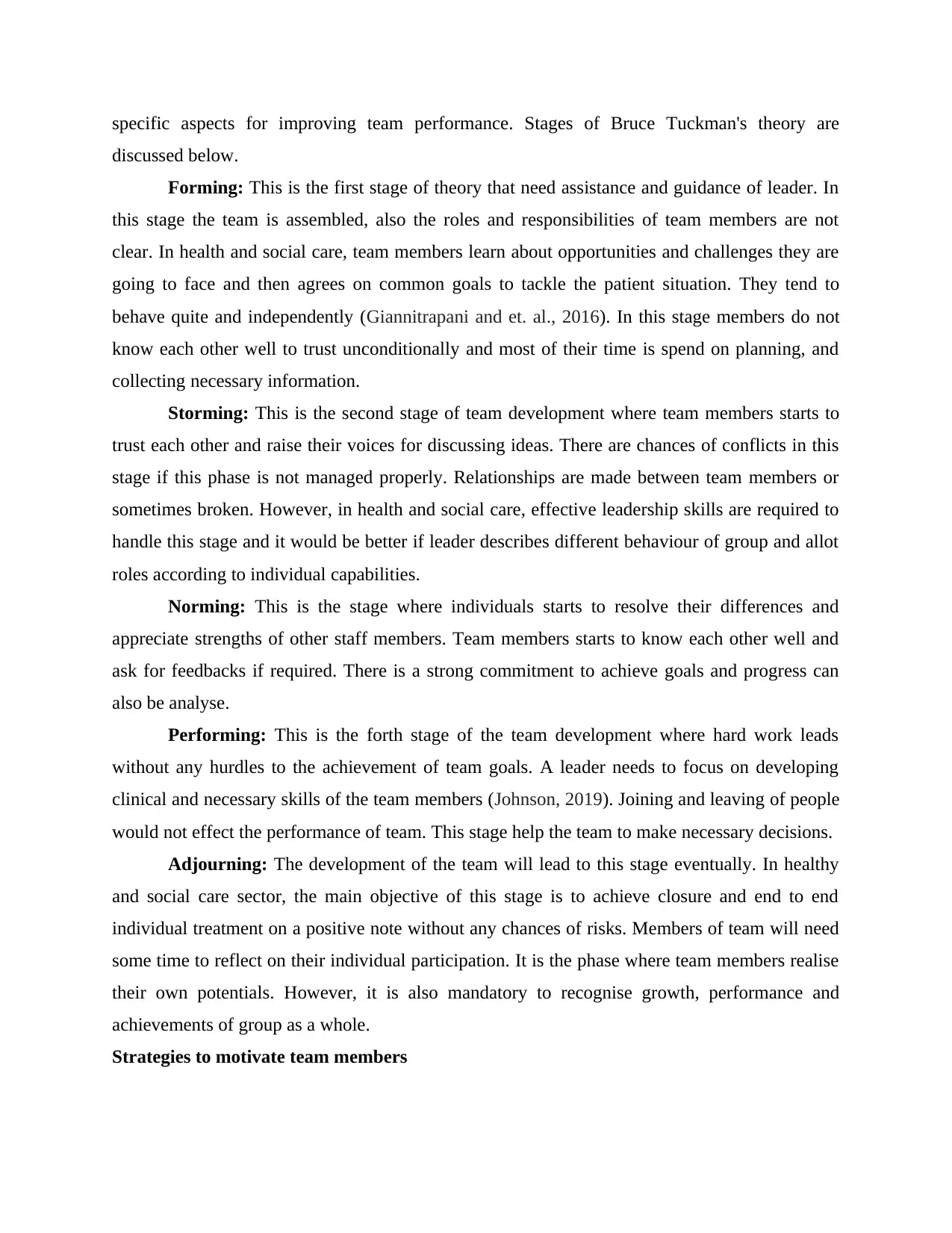
specific aspects for improving team performance. Stages of Bruce Tuckman's theory are
discussed below.
Forming: This is the first stage of theory that need assistance and guidance of leader. In
this stage the team is assembled, also the roles and responsibilities of team members are not
clear. In health and social care, team members learn about opportunities and challenges they are
going to face and then agrees on common goals to tackle the patient situation. They tend to
behave quite and independently (Giannitrapani and et. al., 2016). In this stage members do not
know each other well to trust unconditionally and most of their time is spend on planning, and
collecting necessary information.
Storming: This is the second stage of team development where team members starts to
trust each other and raise their voices for discussing ideas. There are chances of conflicts in this
stage if this phase is not managed properly. Relationships are made between team members or
sometimes broken. However, in health and social care, effective leadership skills are required to
handle this stage and it would be better if leader describes different behaviour of group and allot
roles according to individual capabilities.
Norming: This is the stage where individuals starts to resolve their differences and
appreciate strengths of other staff members. Team members starts to know each other well and
ask for feedbacks if required. There is a strong commitment to achieve goals and progress can
also be analyse.
Performing: This is the forth stage of the team development where hard work leads
without any hurdles to the achievement of team goals. A leader needs to focus on developing
clinical and necessary skills of the team members (Johnson, 2019). Joining and leaving of people
would not effect the performance of team. This stage help the team to make necessary decisions.
Adjourning: The development of the team will lead to this stage eventually. In healthy
and social care sector, the main objective of this stage is to achieve closure and end to end
individual treatment on a positive note without any chances of risks. Members of team will need
some time to reflect on their individual participation. It is the phase where team members realise
their own potentials. However, it is also mandatory to recognise growth, performance and
achievements of group as a whole.
Strategies to motivate team members
discussed below.
Forming: This is the first stage of theory that need assistance and guidance of leader. In
this stage the team is assembled, also the roles and responsibilities of team members are not
clear. In health and social care, team members learn about opportunities and challenges they are
going to face and then agrees on common goals to tackle the patient situation. They tend to
behave quite and independently (Giannitrapani and et. al., 2016). In this stage members do not
know each other well to trust unconditionally and most of their time is spend on planning, and
collecting necessary information.
Storming: This is the second stage of team development where team members starts to
trust each other and raise their voices for discussing ideas. There are chances of conflicts in this
stage if this phase is not managed properly. Relationships are made between team members or
sometimes broken. However, in health and social care, effective leadership skills are required to
handle this stage and it would be better if leader describes different behaviour of group and allot
roles according to individual capabilities.
Norming: This is the stage where individuals starts to resolve their differences and
appreciate strengths of other staff members. Team members starts to know each other well and
ask for feedbacks if required. There is a strong commitment to achieve goals and progress can
also be analyse.
Performing: This is the forth stage of the team development where hard work leads
without any hurdles to the achievement of team goals. A leader needs to focus on developing
clinical and necessary skills of the team members (Johnson, 2019). Joining and leaving of people
would not effect the performance of team. This stage help the team to make necessary decisions.
Adjourning: The development of the team will lead to this stage eventually. In healthy
and social care sector, the main objective of this stage is to achieve closure and end to end
individual treatment on a positive note without any chances of risks. Members of team will need
some time to reflect on their individual participation. It is the phase where team members realise
their own potentials. However, it is also mandatory to recognise growth, performance and
achievements of group as a whole.
Strategies to motivate team members
Paraphrase This Document
Need a fresh take? Get an instant paraphrase of this document with our AI Paraphraser
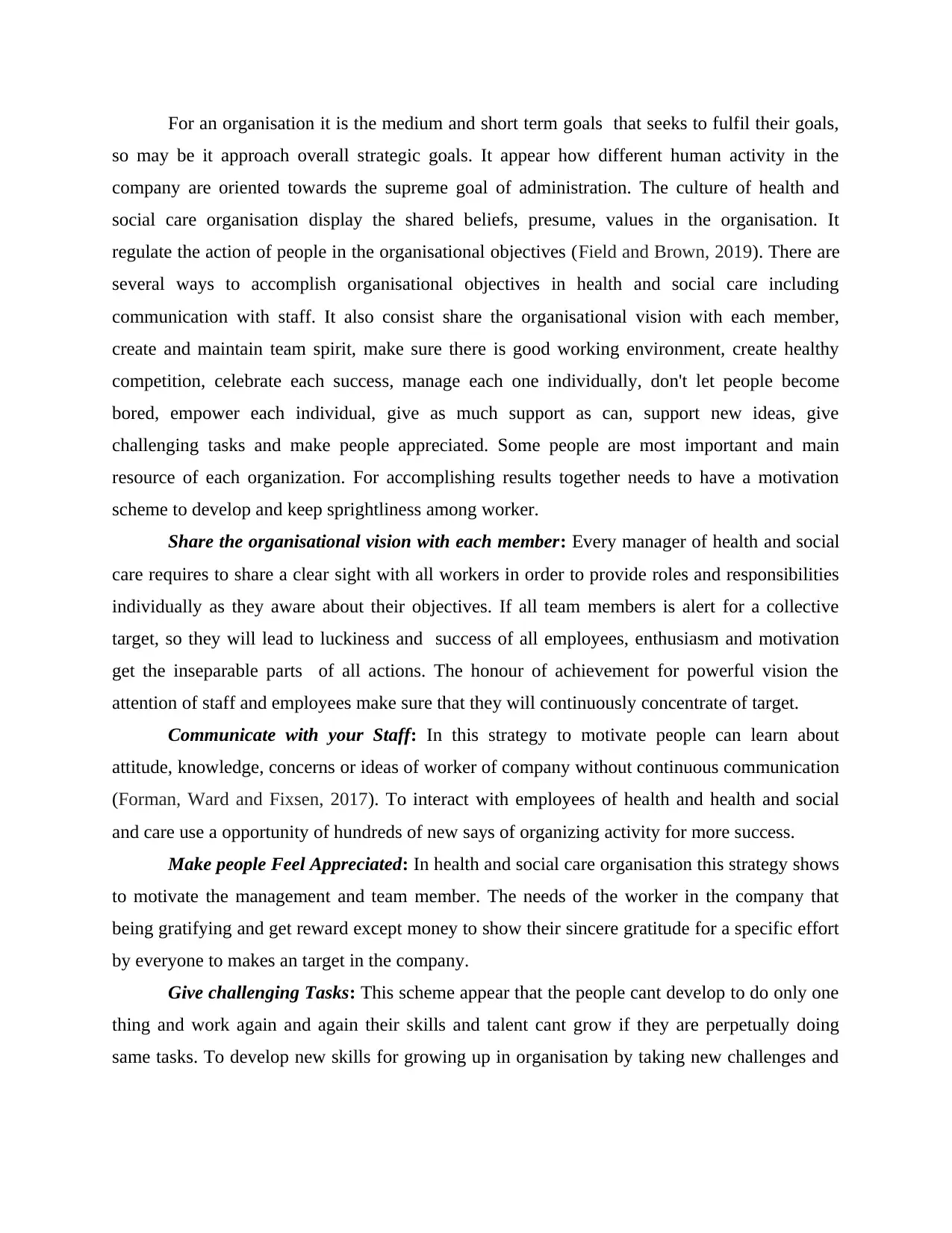
For an organisation it is the medium and short term goals that seeks to fulfil their goals,
so may be it approach overall strategic goals. It appear how different human activity in the
company are oriented towards the supreme goal of administration. The culture of health and
social care organisation display the shared beliefs, presume, values in the organisation. It
regulate the action of people in the organisational objectives (Field and Brown, 2019). There are
several ways to accomplish organisational objectives in health and social care including
communication with staff. It also consist share the organisational vision with each member,
create and maintain team spirit, make sure there is good working environment, create healthy
competition, celebrate each success, manage each one individually, don't let people become
bored, empower each individual, give as much support as can, support new ideas, give
challenging tasks and make people appreciated. Some people are most important and main
resource of each organization. For accomplishing results together needs to have a motivation
scheme to develop and keep sprightliness among worker.
Share the organisational vision with each member: Every manager of health and social
care requires to share a clear sight with all workers in order to provide roles and responsibilities
individually as they aware about their objectives. If all team members is alert for a collective
target, so they will lead to luckiness and success of all employees, enthusiasm and motivation
get the inseparable parts of all actions. The honour of achievement for powerful vision the
attention of staff and employees make sure that they will continuously concentrate of target.
Communicate with your Staff: In this strategy to motivate people can learn about
attitude, knowledge, concerns or ideas of worker of company without continuous communication
(Forman, Ward and Fixsen, 2017). To interact with employees of health and health and social
and care use a opportunity of hundreds of new says of organizing activity for more success.
Make people Feel Appreciated: In health and social care organisation this strategy shows
to motivate the management and team member. The needs of the worker in the company that
being gratifying and get reward except money to show their sincere gratitude for a specific effort
by everyone to makes an target in the company.
Give challenging Tasks: This scheme appear that the people cant develop to do only one
thing and work again and again their skills and talent cant grow if they are perpetually doing
same tasks. To develop new skills for growing up in organisation by taking new challenges and
so may be it approach overall strategic goals. It appear how different human activity in the
company are oriented towards the supreme goal of administration. The culture of health and
social care organisation display the shared beliefs, presume, values in the organisation. It
regulate the action of people in the organisational objectives (Field and Brown, 2019). There are
several ways to accomplish organisational objectives in health and social care including
communication with staff. It also consist share the organisational vision with each member,
create and maintain team spirit, make sure there is good working environment, create healthy
competition, celebrate each success, manage each one individually, don't let people become
bored, empower each individual, give as much support as can, support new ideas, give
challenging tasks and make people appreciated. Some people are most important and main
resource of each organization. For accomplishing results together needs to have a motivation
scheme to develop and keep sprightliness among worker.
Share the organisational vision with each member: Every manager of health and social
care requires to share a clear sight with all workers in order to provide roles and responsibilities
individually as they aware about their objectives. If all team members is alert for a collective
target, so they will lead to luckiness and success of all employees, enthusiasm and motivation
get the inseparable parts of all actions. The honour of achievement for powerful vision the
attention of staff and employees make sure that they will continuously concentrate of target.
Communicate with your Staff: In this strategy to motivate people can learn about
attitude, knowledge, concerns or ideas of worker of company without continuous communication
(Forman, Ward and Fixsen, 2017). To interact with employees of health and health and social
and care use a opportunity of hundreds of new says of organizing activity for more success.
Make people Feel Appreciated: In health and social care organisation this strategy shows
to motivate the management and team member. The needs of the worker in the company that
being gratifying and get reward except money to show their sincere gratitude for a specific effort
by everyone to makes an target in the company.
Give challenging Tasks: This scheme appear that the people cant develop to do only one
thing and work again and again their skills and talent cant grow if they are perpetually doing
same tasks. To develop new skills for growing up in organisation by taking new challenges and
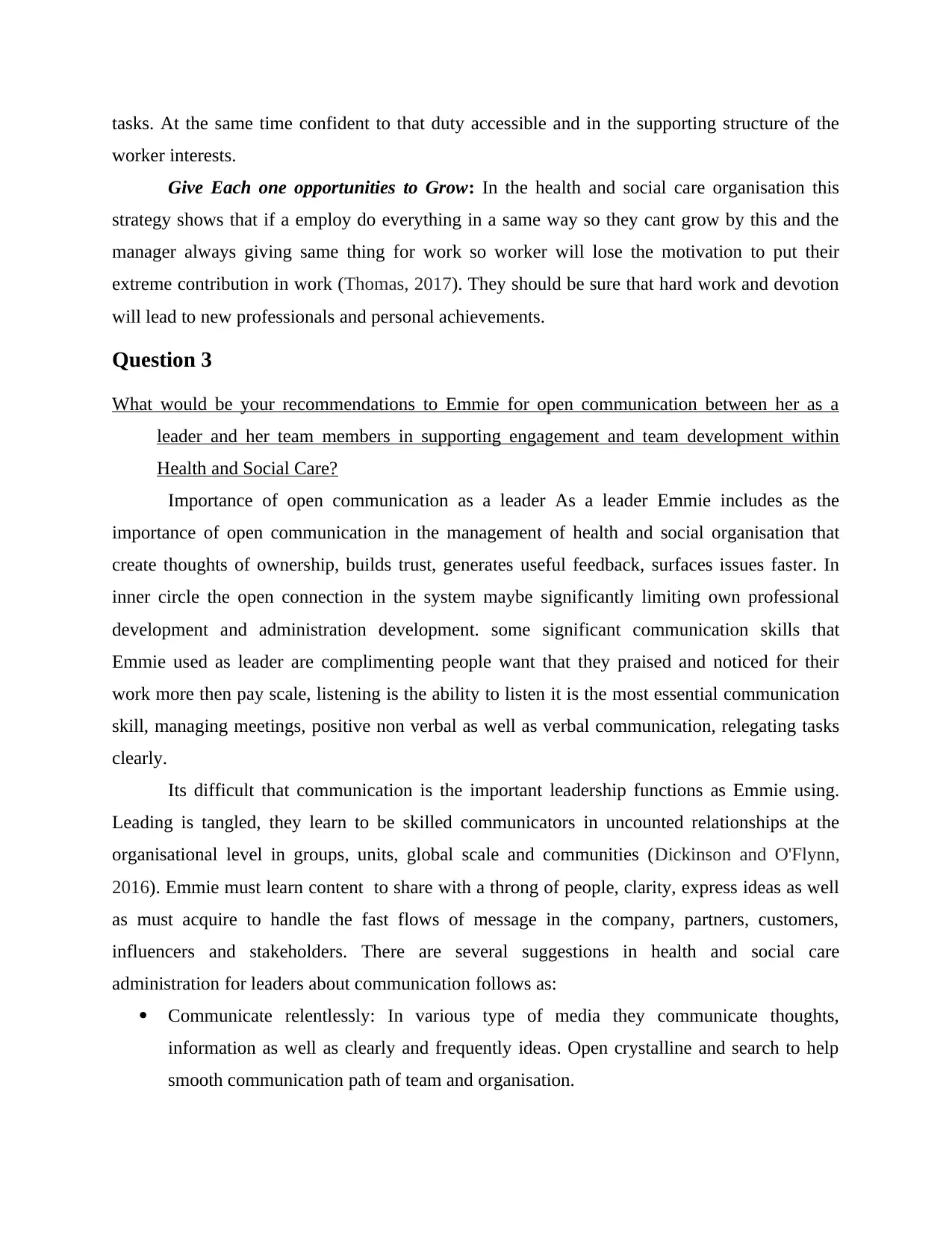
tasks. At the same time confident to that duty accessible and in the supporting structure of the
worker interests.
Give Each one opportunities to Grow: In the health and social care organisation this
strategy shows that if a employ do everything in a same way so they cant grow by this and the
manager always giving same thing for work so worker will lose the motivation to put their
extreme contribution in work (Thomas, 2017). They should be sure that hard work and devotion
will lead to new professionals and personal achievements.
Question 3
What would be your recommendations to Emmie for open communication between her as a
leader and her team members in supporting engagement and team development within
Health and Social Care?
Importance of open communication as a leader As a leader Emmie includes as the
importance of open communication in the management of health and social organisation that
create thoughts of ownership, builds trust, generates useful feedback, surfaces issues faster. In
inner circle the open connection in the system maybe significantly limiting own professional
development and administration development. some significant communication skills that
Emmie used as leader are complimenting people want that they praised and noticed for their
work more then pay scale, listening is the ability to listen it is the most essential communication
skill, managing meetings, positive non verbal as well as verbal communication, relegating tasks
clearly.
Its difficult that communication is the important leadership functions as Emmie using.
Leading is tangled, they learn to be skilled communicators in uncounted relationships at the
organisational level in groups, units, global scale and communities (Dickinson and O'Flynn,
2016). Emmie must learn content to share with a throng of people, clarity, express ideas as well
as must acquire to handle the fast flows of message in the company, partners, customers,
influencers and stakeholders. There are several suggestions in health and social care
administration for leaders about communication follows as:
Communicate relentlessly: In various type of media they communicate thoughts,
information as well as clearly and frequently ideas. Open crystalline and search to help
smooth communication path of team and organisation.
worker interests.
Give Each one opportunities to Grow: In the health and social care organisation this
strategy shows that if a employ do everything in a same way so they cant grow by this and the
manager always giving same thing for work so worker will lose the motivation to put their
extreme contribution in work (Thomas, 2017). They should be sure that hard work and devotion
will lead to new professionals and personal achievements.
Question 3
What would be your recommendations to Emmie for open communication between her as a
leader and her team members in supporting engagement and team development within
Health and Social Care?
Importance of open communication as a leader As a leader Emmie includes as the
importance of open communication in the management of health and social organisation that
create thoughts of ownership, builds trust, generates useful feedback, surfaces issues faster. In
inner circle the open connection in the system maybe significantly limiting own professional
development and administration development. some significant communication skills that
Emmie used as leader are complimenting people want that they praised and noticed for their
work more then pay scale, listening is the ability to listen it is the most essential communication
skill, managing meetings, positive non verbal as well as verbal communication, relegating tasks
clearly.
Its difficult that communication is the important leadership functions as Emmie using.
Leading is tangled, they learn to be skilled communicators in uncounted relationships at the
organisational level in groups, units, global scale and communities (Dickinson and O'Flynn,
2016). Emmie must learn content to share with a throng of people, clarity, express ideas as well
as must acquire to handle the fast flows of message in the company, partners, customers,
influencers and stakeholders. There are several suggestions in health and social care
administration for leaders about communication follows as:
Communicate relentlessly: In various type of media they communicate thoughts,
information as well as clearly and frequently ideas. Open crystalline and search to help
smooth communication path of team and organisation.
⊘ This is a preview!⊘
Do you want full access?
Subscribe today to unlock all pages.

Trusted by 1+ million students worldwide
1 out of 17
Related Documents
Your All-in-One AI-Powered Toolkit for Academic Success.
+13062052269
info@desklib.com
Available 24*7 on WhatsApp / Email
![[object Object]](/_next/static/media/star-bottom.7253800d.svg)
Unlock your academic potential
Copyright © 2020–2025 A2Z Services. All Rights Reserved. Developed and managed by ZUCOL.




